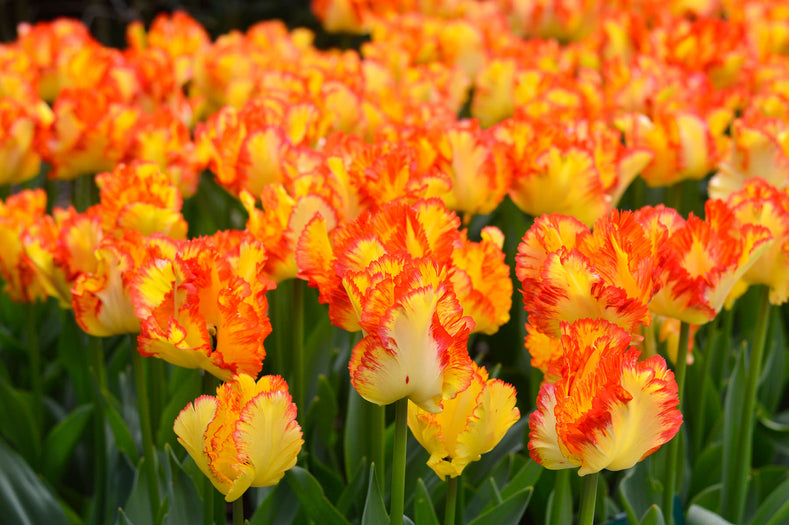Featured Variety: Parrot Tulips
Growing Joy
Here at DutchGrown we love our flower bulbs. They work just as hard for us as we work for them and make it possible for us to have a job where the end product is pure, unadulterated joy. What more could a person want? We are also immensely proud of our flower bulbs. They are big and fertile, guaranteeing a spring time display that will stop anyone in their tracks.
A Special Tulip
Daffodils, hyacinths, crocuses, we’ve got them all and they are all special to us. Every spring when we look at our farmland, the beautiful fields of bright color stretching as far as the eye can see, remind us that all our varieties are special to us, and we wouldn’t want to miss any of them. But…just like a mother who isn’t supposed to have a favorite child but deep down knows that little Charlie is extra special to her, we too have our favorites…And one of them is the parrot tulip.
Why? Well, the parrot is just so frilly, and those colors, I mean…Who wouldn’t be enchanted by those hues? This tulip is so dramatic, rich, almost juicy in appearance that you just can’t resist. The parrot tulip looks beautiful against the green of your grass, stunning in a vase in your living room or kitchen and extremely stylish and opulent in a bouquet.

Flamboyant Mutations
But where do these beauties come from? Like all tulips, the parrot tulip originates in the Near East (From Turkey to the Himalayas, as far south as Iran, as far north as Ukraine). They found their way to the Netherlands in the Eighteenth century, where they were highly prized and extremely expensive. They got their name because the lobed/serrated margins of their flowers give them a kind of ruffled appearance, which is very similar to the feathers of a parrot. Parrot Tulips were developed from mutations of certain late-flowering tulips, and from tulips in the Triumph class. A few varieties, like the Parrot Rococco are fragrant.
Planting and Care
Parrot tulips are hardy to USDA planting zones 4 through 7. They should be planted in full sunlight and fertile, well-drained soil any time between early fall and November. Select a site protected from harsh wind, as long-stemmed parrot tulip flowers are somewhat fragile. Plant the bulbs about 5 inches deep, with 4 to 6 inches between each bulb. Water lightly after planting, then cover the area with 2 to 3 inches of shredded bark, pine needles, or other organic mulch. Remove the mulch as soon as your parrot tulip flowers sprout in spring, somewhere around mid to late April. This is also the time to begin supplemental watering, which should occur weekly until the flowers fade in early summer. Use a hose or drip system and don’t damage the blooms by watering them from above.
Our Parrots
Here at DutchGrown we carry a range of parrot tulips, from greenish white to purply black. Let’s take a look at some of them:
Flaming Parrot brings the feel of the Caribbean to your garden. At the start it’s creamy white with dark red flames, but as the flower matures the white turns a full yellow, showing a striking contrast with the dark flames.
Parrot Estella Rijnveld looks like old-fashioned striped candy or a strawberry sundae. When the sun shines on it, its petals will open completely, giving you a breathtaking display of spring beauty.
A cluster of tulip Caribbean Parrot truly looks like a flock of exotic birds has landed in your garden. These big blooms stand on sturdy stems and will make amazing cut flowers.
My personal favorite is the Rainbow Parrot. I just can’t get enough of this fantastic tulip. Its colors range from purple to red, from yellow to green and from blue to orange. This beauty is exclusively available at DutchGrown. Pre-order now as quantities are very limited!

Pick Your Parrots
Feeling inspired? All you have to do is pick your favorites, order them off our website, and we’ll have them at your door at the best time for planting, so that these very large, brightly colored and flamboyant flowers can have pride of place in your garden come spring.

